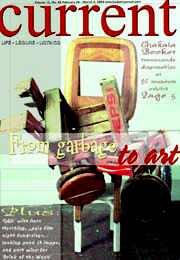They say one man’s garbage may be another man’s gold. Chakaia Booker does not necessarily create her artworks from raw garbage, but she does use dry disposables like rubber tires to make images and sculptures that evoke emotions through abstract expressions.Although many of her pieces are untitled, they are brilliant in colors and minimal in size. About two dozen of her works are being exhibited at the Jersey City Museum on Montgomery Street until the summer. Booker’s show, titled “Jersey Ride,” is a mid-career survey of her work. The exhibition is informed by the idea that despite her lengthy absence from Jersey, much of her work is steeped in the influence of the Garden State’s landscape and the environment in which she spent her formative years.
“Examining her work from the early ’80s through the present, the exhibition explores the depth and breadth of her artistic production and her critical and conceptual use of recycled materials,” said Linda Onorevole, spokeswoman for the museum.
Booker was born in Newark and studied at Rutgers University. She is a soft-spoken humble artist. In order to create her works, she transformed tires and rubber into smooth materials, and she has intertwined their textures, treads, odors, burn and skid marks, and colors into orchestral creations. Booker’s works indirectly puts a spotlight on things like slavery, the industrial revolution, the working class, and factory labor, and more directly it addresses the qualities of rubber. All of her materials are mostly rubber, fiber, wood, metal, food, and furniture, to name some of the main components in her expanding artistic vocabulary. It reminds us of their origins, history, and use. It is not exaggerating to say that Booker’s work often alludes to the fields of archaeology, anthropology, sociology, and psychology.
Booker earned her undergraduate degree in sociology from Rutgers University in 1976 and holds a Master’s of Fine Arts degree from City College of New York (CUNY) in 1993. She has had solo exhibitions at the Neuberger Museum of Art, the Akron Museum of Art, and Marlborough Gallery, and her work is in the collection of the Metropolitan Museum of Art. She participated in the Whitney Biennial in 2000, in the “Twentieth Century American Sculpture” exhibition at the White House in 1996, and in many shows throughout the country and internationally.
She received awards from Anonymous Was A Woman in 2000, The American Academy of Arts and Letters in 2001, and the Pollock-Krasner Foundation in 2002. In 2003, spring and fall exhibitions, at the Storm King Sculpture Park and Marlborough Gallery respectively, will offer viewers a new generation of her works. Booker is in demand as a speaker; recently she lectured at the University of Michigan’s Institute for Research on Women and Gender and School of Art and Design and also at venues in New Orleans and Colorado.
Booker rarely gives interviews to the press, but in a conversation with the art curator and author Jan Garden Castro, Booker said her previous collection “Echoes in Black” dealt with scarification – the processes of emotional and physical scarring that people go through as they deal with universal issues like class, race, and labor.
“Cultural diversity in this society is like tire elements,” she said. “Tires that have been under an explosive moment may retain wonderful visual patterns that come about between the layering of metal treads and the rubber-gluing agents. Sometimes it’s rust stains; other times, it’s the textures, the treads that remain, the movement and coloration that come to me when picking up a piece. As a conceptual analogy, I usually start with the rubber tire itself. It’s about mobility, growth. They’ve used it on the moon. In a large way, it’s our method of communication. The tire-making industry says that the patterns in the tires function to ‘wick away water’ in wet weather. These same patterns may have been a means of communication some time in the past; they may translate into a way of writing, a language or physical tool that actually performs. My intention is to translate materials into imagery that will stimulate people to consider themselves as a part of their environment.”
Booker added she is influenced by the many women in her family, and by friends growing up. When she began her career, she focused on creating materials that were wearable, before moving to full-scale sculptures.
“When I decide to work with a material, I always make a wearable art piece,” she said. “A material evolves in its own way before developing into an artwork. In the mornings when I get up, I sculpt myself first. I myself am sculpture and that continues on a daily basis. At the studio, the process continues. I started making wearable sculpture pieces – and also sculpture – using discarded materials from home: broken plates, the racks that hold the dishes, household items, fruit, bones, and bottle caps.”
Booker will discuss her works at the museum for the “ArtTalk” series on March 25. The Jersey City Museum is at 350 Montgomery St. in Jersey City. For information call (201) 413-0303 or visit www.jerseycitymuseum.org. q
Our Digital Archive from 2000 – 2016
